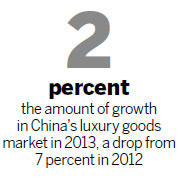Austerity drive among factors taking toll on luxury market

Cosmetics, perfume and the personal care category, a mainstay of China's domestic market that historically generated more than a quarter of all sales, also dropped from 15 percent growth last year to about 10 percent this year.
Bright spots, however, remain in women's categories.
Womenswear and shoes show strong momentum, with growth rates for the year ranging from 8 to 10 percent.
Much of this performance stems from women's increasing sophistication and influence, driving their share of luxury spending in China to equal men's by 2013 - a rapid evolution from 1995, when more than 90 percent of spending was done by men.
"China's luxury market has quickly changed from land-grab to a steady focus on consumer experience and 'like for like' sales," said Bruno Lannes, a Bain partner in China and lead author of the Chinese edition of the study.
"The mind-set among global brands here is changing from men's categories and accessories to women's categories and fashion. Brands are preparing for this major shift," Lannes said.
In light of the market evolution, store expansion is no longer enough to drive growth.
The number of new openings by global brands in China declined by one-third to roughly 100 last year from 150 in 2012 for the 20 brands involved in the study.
The new focus is renovation, relocation and operational improvement for domestic shoppers, as "like for like" sales were negative for most brands in 2013.
Marketing and sales channels are quickly shifting as well. The study found that 73 percent of consumers use the Internet to get information about luxury goods before they buy.
The market also is greatly polarizing at the highest and lowest ends of the luxury products spectrum.
For example, in handbags, 25 percent of luxury brands' prices fall under 5,000 yuan ($826), while 33 percent top 20,000 yuan.
















